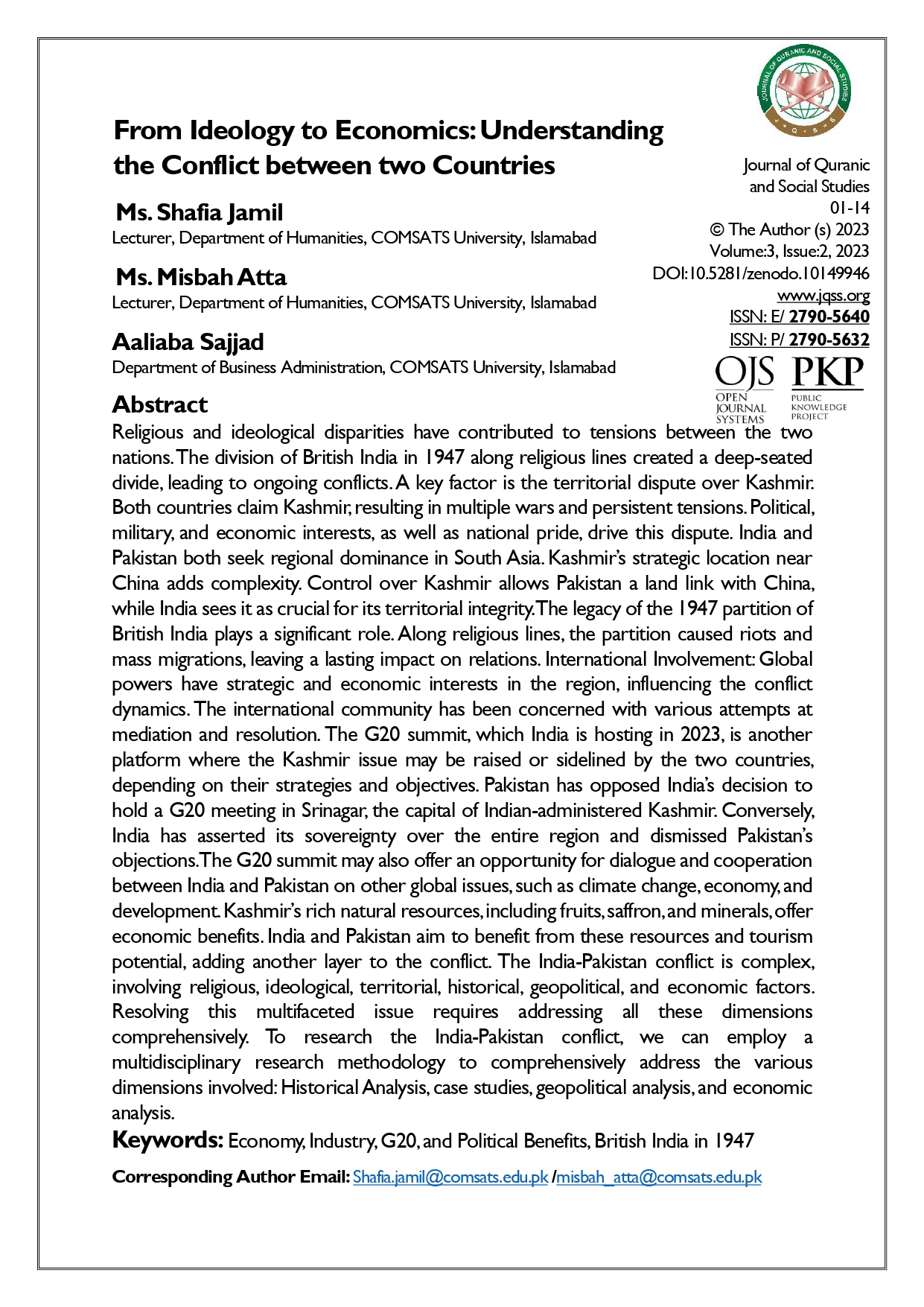From Ideology to Economics: Understanding the Conflict between two Countries
DOI:
https://doi.org/10.5281/zenodo.10149946Abstract
Religious and ideological disparities have contributed to tensions between the two nations. The division of British India in 1947 along religious lines created a deep-seated divide, leading to ongoing conflicts. A key factor is the territorial dispute over Kashmir. Both countries claim Kashmir, resulting in multiple wars and persistent tensions. Political, military, and economic interests, as well as national pride, drive this dispute. India and Pakistan both seek regional dominance in South Asia. Kashmir’s strategic location near China adds complexity. Control over Kashmir allows Pakistan a land link with China, while India sees it as crucial for its territorial integrity. The legacy of the 1947 partition of British India plays a significant role. Along religious lines, the partition caused riots and mass migrations, leaving a lasting impact on relations. International Involvement: Global powers have strategic and economic interests in the region, influencing the conflict dynamics. The international community has been concerned with various attempts at mediation and resolution. The G20 summit, which India is hosting in 2023, is another platform where the Kashmir issue may be raised or sidelined by the two countries, depending on their strategies and objectives. Pakistan has opposed India’s decision to hold a G20 meeting in Srinagar, the capital of Indian-administered Kashmir. Conversely, India has asserted its sovereignty over the entire region and dismissed Pakistan’s objections. The G20 summit may also offer an opportunity for dialogue and cooperation between India and Pakistan on other global issues, such as climate change, economy, and development. Kashmir’s rich natural resources, including fruits, saffron, and minerals, offer economic benefits. India and Pakistan aim to benefit from these resources and tourism potential, adding another layer to the conflict. The India-Pakistan conflict is complex, involving religious, ideological, territorial, historical, geopolitical, and economic factors. Resolving this multifaceted issue requires addressing all these dimensions comprehensively. To research the India-Pakistan conflict, we can employ a multidisciplinary research methodology to comprehensively address the various dimensions involved: Historical Analysis, case studies, geopolitical analysis, and economic analysis.
References
Bhat, B. A. "A Study on Jammu and Kashmir Present, Past, and Views of Students on Article 370 Abrogation." International Journal of Latest Research in Humanities and Social Science (IJLRHSS) 2, no. 12 (2019): 3-7.
Bhat, T. A., and T. Choure. "Status and Strength of Apple Industry in Jammu and Kashmir." International Journal of Research 1, no. 4 (2014): 277-283.
Kianimanesh, K., Jaimand, K., Lebaschi, M. H., Tabaei-Aghdaei, S. R., and Karimi, S. "Essential Oils from Flower Petals of Saffron (Crocus sativus)." Journal of Ethno-Pharmaceutical Products 2, no. 2 (2021): 78-84.
Hughes, R. W., W. Manorotkul, and E. B. Hughes. Ruby & Sapphire: A Gemologist's Guide. RWH Publishing, 2017.
Jasmine, N. W. "Kashmir Regional Border Dispute Between India and Pakistan." (2022).
Ankit, R. The Kashmir Conflict: From Empire to the Cold War, 1945-66. Routledge, 2016.
Ganguly, Š. Conflict Unending: India-Pakistan Tensions Since 1947. Columbia University Press, 2002.
Schofield, V. "Kashmir in Conflict: India, Pakistan, and the Unending War." Mountain Research and Development 32, no. 1 (2012): 101-103.
Zutshi, C., ed. Kashmir: History, Politics, Representation. Cambridge University Press, 2017.
Mehsud, M. I., M. Adnan, and A. Jan. "The Hydropolitics of the Indus Waters Treaty: A Critical." (2020).
Omer Aijazi. "India is Using the G20 Summit to Further its Settler-Colonial Ambitions in Kashmir." University of Victoria, May 16, 2023, 10:17pm BST.
Hussain, A. "Pakistan Criticises India’s Move to Host G20 Meeting in Srinagar." Border Disputes News | Al Jazeera, April 11, 2023.
Abbas, H., and H. Abbas. "Pakistan Condemns India for Holding a G20 Meeting in Srinagar." Daily Times, April 11, 2023.
"Event: G20 Leaders’ Summit 2023 | SDG Knowledge Hub | IISD." IISD, n.d.
"G20 Summit: What is on the Agenda and What Has Happened at the Meetings So Far?" The Indian Express, September 6, 2023.
"G20 New Delhi Summit 2023: Which Countries and Leaders Will Attend?" Reuters, September 4, 2023.
"What to Expect as India Assumes G20 Presidency for 2023." News | Al Jazeera, December 2, 2022.
"SSP Srinagar Ensures Action Against Bribes or Favor by Any Police Officer of District, Issues Helpline." Rising Kashmir, n.d.
"Is India Projecting ‘Normalcy’ in Kashmir by Holding G20 Meeting?" Conflict News | Al Jazeera, May 17, 2023.
"Third G20 Tourism Meeting to Be Organized from 22nd to 24th May at Srinagar." n.d.
Ganguly, S., M. Smetana, S. Abdullah, and A. Karmazin. "India, Pakistan, and the Kashmir Dispute: Unpacking the Dynamics of a South Asian Frozen Conflict." Asia Europe Journal 17, no. 2 (2019): 129-143.
Chaudhury, D. R. "India to Host G20 Summit in 2023." The Economic Times, 2020.
Kashoon Leeza. "Conflict Transformation: A Sustainable Solution for Indo-Pak Conflict." South Asian Voices, May 22, 2019.
Moeed Yusuf. "What Can Be Done to Calm the India-Pakistan Crisis?" United States Institute of Peace, February 27, 2019.
Jacob, Happymon. "Toward a Kashmir Endgame? How India and Pakistan Could Negotiate a Lasting Solution." United States Institute of Peace, August 5, 2020.

Downloads
Published
How to Cite
Issue
Section
License
Copyright (c) 2023 Author

This work is licensed under a Creative Commons Attribution-NonCommercial 4.0 International License.



























